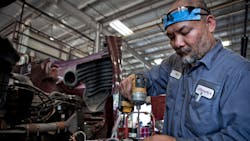Can you outsource your in-house maintenance department?
In a 2019 Fleet Maintenance readership study, 85.7 percent of respondents indicated they conduct at least some of their own maintenance on-site or utilize a central corporate facility to manage maintenance work. This means 14.3 percent of respondents completely outsource their maintenance – whether to an independent service provider or a dealership. That number – those who outsource maintenance – is up 1.3 percent from 2018.
However, there is more to the story on how in-house versus outsourced maintenance is handled within a fleet. The nuances of every fleet’s maintenance operations practices vary. Many fleets conduct a portion of maintenance work in-house while relying on outside service providers to assist with the rest.
According to Dave Walters, senior solutions engineer for Trimble, on average, a fleet keeps about 70 percent of its overall maintenance in-house.
“Most fleets will do at least 30 percent of their maintenance outside of their own maintenance network, and we see that increasing,” he says.
Work handled by outside service providers typically involves more extensive maintenance services like engine or transmission overhauls or employing unexpected mobile breakdown service, as well as relying on dealerships to provide warranty service.
What about those fleets who do handle all maintenance in-house? Fleets have increasingly assessed how to capitalize on their in-house expertise.
Make the most of maintenance expertise
There has been a continued push by larger fleets who already conduct much of their own maintenance work to also become an outsourced maintenance provider themselves. Since fleets that are already conducting all of their own maintenance have invested in the training of technicians, these operations have looked to open up their bays to others in the industry who need service work.
“Most of the major fleets are opening their own shops to do this maintenance, to fill up their bays,” notes Renaldo Adler, industry principal for asset maintenance for Trimble.
“They're really off selling their excess capacity,” adds Walters. “It makes total sense and lowers expenses in their own fleets.”
Selling off this excess capacity has provided these fleets a means to add to the bottom line and make best use of their bays and technician knowledge.
“Some fleets have decided to step away from in-house maintenance and outsource it,” Walters says. “Others have tried outsourcing and are bringing it back in, but what you might find in those cases is those fleets … begin to use that investment in shop technicians’ training to do repairs for other folks, and actually create profit centers.”
Impact on CMMS software
During discussions researching this month’s cover story on computerized maintenance management (CMMS) software trends, Adler and Walters shared insight on this trend they’ve noticed with their own CMMS customers: more are looking to manage their maintenance operations with a software that allows for not only managing their own fleet but having access to provide billing and service information for their shop’s outside maintenance customers.
“The traditional CMMS, which typically handles the fleet’s assets, is now being asked to do retail type functions, which we've played in that space for a number of years now and it’s growing,” Walters says.
“I would say 30 to 40 percent of our new customers that we add today are what we call service centers,” he adds. “They are fleets that own assets that are now turning their shops into profit centers.”
To address this trend, Trimble has understandably developed two types of fleet maintenance software management products: one for the standard in-house fleet maintenance model, and one that serves as a service center product for retail environments.
Regardless of the type of maintenance operations, though, standard repair times (SRTs) seem to be more and more prevalent. When it comes to in-house operations, monitoring SRTs allows fleets the ability to measure technician productivity, identifying areas where employees are working efficiently or may pinpoint training needs. And, when it comes to a fleet who has turned their own maintenance operation into a profit center, it provides a means to track the cost of technician hours for billing.
About the Author
Erica Schueller
Media Relations Manager | Navistar
Erica Schueller is the Media Relations Manager for Navistar.
Before joining Navistar, Schueller served as Editorial Director of the Endeavor Commercial Vehicle Group. The commercial vehicle group includes the following brands: American Trucker, Bulk Transporter, Fleet Maintenance, FleetOwner, Refrigerated Transporter, and Trailer/Body Builders brands.
An award-winning journalist, Schueller has reported and written about the vehicle maintenance and repair industry her entire career. She has received accolades for her reporting and editing in the commercial and automotive vehicle fields by the Truck Writers of North America (TWNA), the International Automotive Media Competition (IAMC), the Folio: Eddie & Ozzie Awards and the American Society of Business Publication Editors (ASBPE) Azbee Awards.
Schueller has received recognition among her publishing industry peers as a recipient of the 2014 Folio Top Women in Media Rising Stars award, acknowledging her accomplishments of digital content management and assistance with improving the print and digital products in the Vehicle Repair Group. She was also named one Women in Trucking’s 2018 Top Women in Transportation to Watch.
She is an active member of a number of industry groups, including the American Trucking Associations' (ATA) Technology & Maintenance Council (TMC), the Auto Care Association's Young Auto Care Networking Group, GenNext, and Women in Trucking.
In December 2018, Schueller graduated at the top of her class from the Waukesha County Technical College's 10-week professional truck driving program, earning her Class A commercial driver's license (CDL).
She has worked in the vehicle repair and maintenance industry since 2008.

